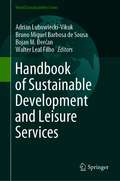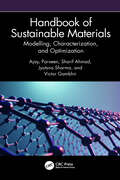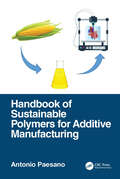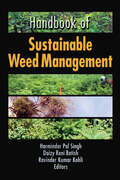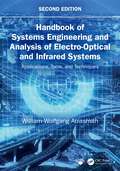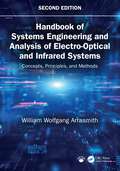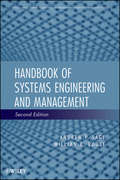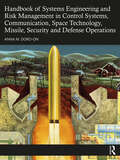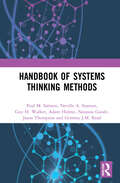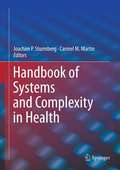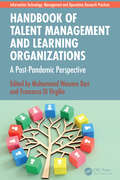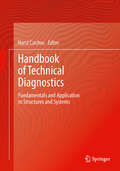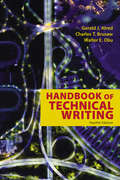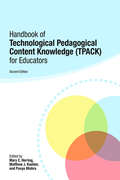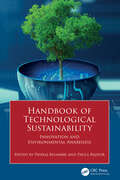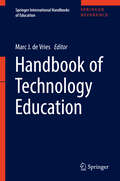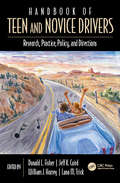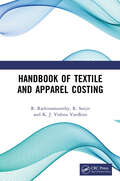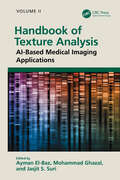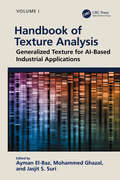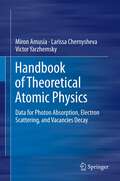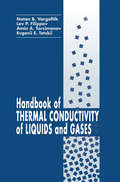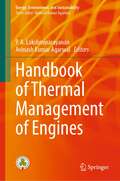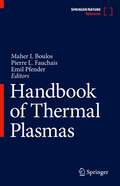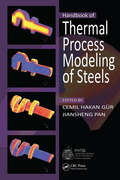- Table View
- List View
Handbook of Sustainable Development and Leisure Services (World Sustainability Series)
by Walter Leal Filho Adrian Lubowiecki-Vikuk Bruno Miguel Barbosa de Sousa Bojan M. ĐerčanThis book reviews empirical and theoretical research on sustainable development in the context of leisure management for communities. Although leading research centers are pursuing interdisciplinary research on leisure in the context of sustainable development, there are still few papers that holistically address the current challenges in this area. In addition, demographic changes have made the promotion of a healthy lifestyle essential. Doing so requires responsible behavior on the part of various stakeholders in this market.This book fills an important gap in the literature and gathers contributions from an interdisciplinary and international team of authors, whose fields of expertise include human geography, management, intersections of sustainability and leisure, behavioral psychology and tourism.
Handbook of Sustainable Materials: Modelling, Characterization, And Optimization
by Ajay Parveen Sharif Ahmad Jyotsna Sharma Victor GambhirHandbook of Sustainable Materials presents recent developments in sustainable materials and how these materials interact with the environment. It highlights the recent advancements involved in proper utilization of sustainable materials, including chemical and biological approaches. With chapters written by global experts, the book offers a guide and insights into sustainable materials from a variety of engineering disciplines. Each chapter provides in-depth technical information on the sustainable materials theory and explores synthesis strategies, green materials, and artificial intelligence. The book considers applications in sectors such as aerospace, automobile, and biomedical for rapid prototyping and customized production without negative environmental impacts. It features research outcomes and case studies of optimization and modeling techniques in practice. Features: Presents recent developments in sustainable materials from various engineering fields and industry applications. Emphasizes analytical strategies, computational, and simulation approaches develop innovative sustainable materials. Discusses an artificial intelligence approach, rapid prototyping, and customized production. This book is designed for researchers and professionals working with sustainable materials, clean manufacturing, and environmental impacts.
Handbook of Sustainable Polymers for Additive Manufacturing
by Antonio PaesanoThis book provides the latest technical information on sustainable materials that are feedstocks for additive manufacturing (AM). Topics covered include an up-to-date and extensive overview of raw materials, their chemistry, and functional properties of their commercial versions; a description of the relevant AM processes, products, applications, advantages, and limitations; prices and market data; and a forecast of sustainable materials used in AM, their properties, and applications in the near future. Data included are relative to current commercial products and are presented in easy-to-read tables and charts. Features Highlights up-to-date information and data of actual commercial materials Offers a broad survey of state-of the-art information Forecasts future materials, applications, and areas of R&D Contains simple language, explains technical terms, and minimizes technical lingo Includes over 200 tables, nearly 200 figures, and more than 1,700 references to technical publications, mostly very recent Handbook of Sustainable Polymers for Additive Manufacturing appeals to a diverse audience of students and academic, technical, and business professionals in the fields of materials science and mechanical, chemical, and manufacturing engineering.
Handbook of Sustainable Weed Management
by Ravinder Kumar Kohli Harminder Pal Singh Daizy Rani BatishInnovative Strategies for Managing Weeds in an Environmentally Protective MannerSuccessfully meeting the challenge of providing weed control without relying on dangerous chemicals that endanger the ecosystem or human lives, this compendium focuses on management strategies that reduce herbicidal usage, restore ecological balance, and incr
Handbook of Systems Engineering and Analysis of Electro-Optical and Infrared Systems: Applications, Tools, and Techniques
by William Wolfgang ArrasmithThere has been a lot of innovation in systems engineering and some fundamental advances in the field of optics, imaging, lasers, and photonics that warrant attention. This volume focuses on applications, tools, and techniques of systems engineering‑related topics from government, industrial, and academic settings such as development and operations (DevOps), agile methods, and the concept of the “digital twin.”Handbook of Systems Engineering and Analysis of Electro‑Optical and Infrared Systems: Applications, Tools, and Techniques offers more information on the application of decision and risk analysis and statistical methods in systems engineering such as design of experiments (DOX) methods, including statistical process control, hypothesis testing, analysis of variance, blocking, 2k factorial analysis, and regression analysis. It includes new material using model‑based systems engineering and systems architecture methods in a system‑level design application. The integration of recent high‑speed atmospheric turbulence research results in the optical technical examples and case studies to illustrate the new developments is also included. A presentation of new optical technical materials for adaptive optics (AO) and atmospheric turbulence compensation (ATC) systems that are based on illumination from passive sources (natural light) or active sources (coherent light like from lasers) provides the technical focus for the systems engineering methods and techniques. Chapter 13 focuses on the technical aspects of the design process and uses the systems-level design as an illustration. In addition to covering lifecycle cost estimation methods and applying them to an integrated case study that is used to illustrate important concepts and techniques throughout this work, the final section brings everything together in terms of technical, cost, and schedule performance.Because this volume blends modern‑day systems engineering methods with detailed optical systems analysis and applies these methodologies to EO/IR systems, this new edition is an excellent text for professionals in STEM disciplines that work with optical or infrared systems. It’s also a great practical reference text for the practicing engineer and a solid educational text for graduate‑level systems engineering, engineering, science, and technology students.
Handbook of Systems Engineering and Analysis of Electro-Optical and Infrared Systems: Concepts, Principles, and Methods
by William Wolfgang ArrasmithThere has been a lot of innovation in systems engineering and some fundamental advances in the fields of optics, imaging, lasers, and photonics that warrant attention. This volume focuses on concepts, principles, and methods of systems engineering‑related topics from government, industrial, and academic settings such as development and operations (DevOps), agile methods, and the concept of the “digital twin.”Handbook of Systems Engineering and Analysis of Electro‑Optical and Infrared Systems: Concepts, Principles, and Methods offers more information on decision and risk analysis and statistical methods in systems engineering such as design of experiments (DOX) methods, hypothesis testing, analysis of variance, blocking, 2k factorial analysis, and regression analysis. It includes new material on systems architecture to properly guide the evolving system design and bridge the gap between the requirements generation and design efforts. The integration of recent high‑speed atmospheric turbulence research results in the optical technical examples and case studies to illustrate the new developments is also included. A presentation of new optical technical materials on adaptive optics (AO), atmospheric turbulence compensation (ATC), and laser systems along with more are also key updates that are emphasized in the second edition 2‑volume set.Because this volume blends modern‑day systems engineering methods with detailed optical systems analysis and applies these methodologies to EO/IR systems, this new edition is an excellent text for professionals in STEM disciplines who work with optical or infrared systems. It’s also a great practical reference text for practicing engineers and a solid educational text for graduate‑level systems engineering, engineering, science, and technology students.
Handbook of Systems Engineering and Management
by Andrew P. Sage William B. RouseThe trusted handbook--now in a new editionThis newly revised handbook presents a multifaceted view of systems engineering from process and systems management perspectives. It begins with a comprehensive introduction to the subject and provides a brief overview of the thirty-four chapters that follow. This introductory chapter is intended to serve as a "field guide" that indicates why, when, and how to use the material that follows in the handbook.Topical coverage includes: systems engineering life cycles and management; risk management; discovering system requirements; configuration management; cost management; total quality management; reliability, maintainability, and availability; concurrent engineering; standards in systems engineering; system architectures; systems design; systems integration; systematic measurements; human supervisory control; managing organizational and individual decision-making; systems reengineering; project planning; human systems integration; information technology and knowledge management; and more.The handbook is written and edited for systems engineers in industry and government, and to serve as a university reference handbook in systems engineering and management courses. By focusing on systems engineering processes and systems management, the editors have produced a long-lasting handbook that will make a difference in the design of systems of all types that are large in scale and/or scope.
Handbook of Systems Engineering and Risk Management in Control Systems, Communication, Space Technology, Missile, Security and Defense Operations
by Anna M. Doro-onThis book provides multifaceted components and full practical perspectives of systems engineering and risk management in security and defense operations with a focus on infrastructure and manpower control systems, missile design, space technology, satellites, intercontinental ballistic missiles, and space security. While there are many existing selections of systems engineering and risk management textbooks, there is no existing work that connects systems engineering and risk management concepts to solidify its usability in the entire security and defense actions. With this book Dr. Anna M. Doro-on rectifies the current imbalance. She provides a comprehensive overview of systems engineering and risk management before moving to deeper practical engineering principles integrated with newly developed concepts and examples based on industry and government methodologies. The chapters also cover related points including design principles for defeating and deactivating improvised explosive devices and land mines and security measures against kinds of threats. The book is designed for systems engineers in practice, political risk professionals, managers, policy makers, engineers in other engineering fields, scientists, decision makers in industry and government and to serve as a reference work in systems engineering and risk management courses with focus on security and defense operations.
Handbook of Systems Thinking Methods
by Jason Thompson Neville A. Stanton Guy H. Walker Paul M. Salmon Natassia Goode Adam Hulme Gemma J.M. ReadThe systems thinking philosophy has become popular in human factors and ergonomics and safety science. These methods are being used to understand and resolve complex societal problems in areas such as transport safety, workplace safety, medication error, disaster management, child abuse, financial crises, terrorism, climate change and public health and wellbeing. This handbook presents practical step-by-step guidance for practitioners and researchers wishing to use these methods to tackle complex problems. Each method includes an example case study which demonstrates how the method can be applied and how the results can be interpreted and translated into practical recommendations. The book presents practical guidance on state-of-the-art systems thinking methods and offers case study applications describing systems thinking methods in novel areas. It explains how to translate the outputs of systems thinking methods in practice and introduces systems thinking with an overview of Human Factors and Ergonomics applications. This book will serve as a great reference for students and engineers in the field of systems engineering, complex systems and the design and development of systems, including ergonomics/human factors and systems engineers, designers, architects, industrial engineers, project management engineers, reliability engineers, risk engineers, software engineers and computer engineers.
Handbook of Systems and Complexity in Health
by Carmel Martin Joachim P SturmbergThis book is an introduction to health care as a complex adaptive system, a system that feeds back on itself. The first section introduces systems and complexity theory from a science, historical, epistemological, and technical perspective, describing the principles and mathematics. Subsequent sections build on the health applications of systems science theory, from human physiology to medical decision making, population health and health services research. The aim of the book is to introduce and expand on important population health issues from a systems and complexity perspective, highlight current research developments and their implications for health care delivery, consider their ethical implications, and to suggest directions for and potential pitfalls in the future.
Handbook of Talent Management and Learning Organizations: A Post-Pandemic Perspective (Information Technology, Management and Operations Research Practices)
by Francesca Di Virgilio Muhammad Waseem BariThis handbook contributes to the advanced knowledge of talent management and learning organizations in the post-pandemic era. It provides new insights and contributions to the existing literature on business organizations through the dissemination of information as well as empirical pieces of evidence from various parts of the world. The focus of this handbook is on advancing talent management strategies and learning organizations through knowledge sharing on various platforms, geographical locations, and diverse groups of intellectuals having diversified experience, knowledge, and expertise. It also focuses on innovation and creativity based on global competition, advanced communication, and management technologies and on changing customers’ behaviors and needs in the post-pandemic era.The Handbook of Talent Management and Learning Organizations: A Post-Pandemic Perspective explores theoretical and empirical artifacts and different approaches to enhance the understanding of the relationship between talent management and learning organization. It provides solutions to managers and consultants who are facing problems while managing talent due to workplace changes post-pandemic and shows the connection between innovation and creativity as talent management enhances organizational learning, knowledge-sharing culture, innovation capabilities, and creativity. The handbook also offers strategies and solutions to manage talent virtually and presents future research directions and solutions to contemporary issues related to talent management and learning organizations moving forward.This handbook targets graduate students, research scholars, practitioners, employees, consultants, corporate bodies, and technocrats. It will be very helpful to managers and consultants who are facing problems with managing talent due to workplace changes after the pandemic.
Handbook of Technical Diagnostics: Fundamentals and Application to Structures and Systems
by Horst CzichosThis book presents concepts, methods and techniques to examine symptoms of faults and failures of structures, systems and components and to monitor functional performance and structural integrity. The book is organized in five parts. Part A introduces the scope and application of technical diagnostics and gives a comprehensive overview of the physics of failure. Part B presents all relevant methods and techniques for diagnostics and monitoring: from stress, strain, vibration analysis, nondestructive evaluation, thermography and industrial radiology to computed tomography and subsurface microstructural analysis. Part C cores the principles and concepts of technical failure analysis, illustrates case studies, and outlines machinery diagnostics with an emphasis on tribological systems. Part D describes the application of structural health monitoring and performance control to plants and the technical infrastructure, including buildings, bridges, pipelines, electric power stations, offshore wind structures, and railway systems. And finally, Part E is an excursion on diagnostics in arts and culture. The book integrates knowledge of basic sciences and engineering disciplines with contributions from research institutions, academe, and industry, written by internationally known experts from various parts of the world, including Europe, Canada, India, Japan, and USA.
Handbook of Technical Writing
by Gerald J. Alred Charles T. Brusaw Walter E. Oliu<P><P> This classic book remains the complete technical-writing reference for students and professionals alike. Alphabetically organized and easy-to-use, its nearly 400 entries provide guidance for writing all the most common types of professional documents and correspondence, including reports, proposals, manuals, memos, and white papers. Abundant real-world sample documents and visuals throughout the book demonstrate effective technical communication, reflecting current practices for formatting documents and using email. In addition, advice for organizing, researching, writing, and revising complements thorough treatment of grammar, usage, style, and punctuation to provide comprehensive help with writing skills. <P><P> This edition has been thoroughly revised to include updated advice for analyzing the context of different writing situations, using and integrating visuals, and dealing with ethical concerns in technical writing. Expanded coverage of the latest types of writing for the Web discusses FAQs and blogs as forms of collaborative writing and business promotion. New Digital Tips focus on using technology to assist with writing tasks, such as using wikis for collaborative documents. <P><P> Entries throughout the book have been revised, updated, consolidated, and streamlined to provide the most accurate and accessible information. Comprehensive yet concise, the Handbook of Technical Writing remains the quick reference faithful users have come to appreciate.
Handbook of Technological Pedagogical Content Knowledge (TPACK) for Educators
by Mary C. Herring, Matthew J. Koehler and Punya MishraThe 2nd edition of the Handbook of Technological Pedagogical Content Knowledge (TPACK) for Educators addresses the concept and implementation of technological pedagogical content knowledge—the knowledge and skills that teachers need in order to integrate technology meaningfully into instruction in specific content areas. Driven by the growing influence of TPACK on research and practice in both K-12 and higher education, the 2nd edition updates current thinking about theory, research, and practice. Offering a series of chapters by scholars in different content areas who apply the technological pedagogical content knowledge framework to their individual content areas, the volume is structured around three themes: Current thoughts on TPACK Theory Research on Technological Pedagogical Content Knowledge in Specific Subject Areas Integrating Technological Pedagogical Content Knowledge into Teacher Education and Professional Development The Handbook of Technological Pedagogical Content Knowledge (TPACK) for Educators is simultaneously a mandate and a manifesto on the engagement of technology in classrooms.
Handbook of Technological Sustainability: Innovation and Environmental Awareness
by Pankaj Bhambri and Paula BajdorIn the context of an ever-changing technological world, it is crucial to prioritize the cultivation of sustainability and environmental consciousness. Adopting an interdisciplinary perspective, this handbook facilitates the integration of technology and sustainability by leveraging insights from many fields such as engineering, environmental science, economics, and sociology. The primary objective of this handbook is to provide a comprehensive analysis of the complex relationship between technology and the environment.Handbook of Technological Sustainability: Innovation and Environmental Awareness includes recent and diverse case studies from a global perspective and demonstrates the utilization of technology to achieve sustainable development across several sectors, such as energy, agriculture, transportation, and urban planning. It explores innovative technologies emphasizing state-of-the-art and developing technologies, including renewable energy, circular economy practices, smart cities, and artificial intelligence-driven sustainability solutions. The handbook also examines the impact of laws, regulations, and international agreements on the advancement or impediment of technological sustainability. Written to be used as a reference, this handbook highlights the ethical and moral quandaries linked to technological sustainability analyzing various topics of significance, including environmental justice, privacy implications in smart technology, and the ramifications of artificial intelligence on employment and society. It provides practical methodologies and recommendations for individuals, enterprises, and governmental entities to adopt and integrate sustainable technologies effectively and furnish readers with a comprehensive guide for transitioning towards a more sustainable future.As it showcases perspectives from technologists, sustainability professionals, and policymakers that have the potential to provide a range of opinions and practical insights derived from real-world experiences, this handbook is a book for all individuals, corporations, governments, researchers, and anyone seeking to harness technology to advance sustainability and effectively tackle the multifaceted issues posed by our dynamic global landscape.
Handbook of Technology Education
by Marc J. de VriesThis handbook of technology education offers a state-of-the-art survey of developments in technology education worldwide. It deals with general themes like philosophical foundations, curriculum, teaching and learning, teacher education, and educational technology. It also has some technology-specific topics, such as designing, making, and assessment (portfolios). To focus on the specific learning challenges a separate section of the book is dedicated to sub-domains of technology and engineering, like food, textiles, materials and robotics. Explicit attention is given to the possible role of technology (and engineering) education in Science, Technology, Engineering and Mathematics (STEM) education. Recent developments such as technology concept learning, authentic learning, pre-university engineering education, design-based learning and design-based research for technology education, pedagogical content knowledge for technology educators, and the use of e-portfoli os are included. One section deals with social and cultural issues, such as education for sustainability, gender issues in technology education, indigenous technologies, industry involvement and the relation between technology education and communication. As could be expected in a handbook on technology education, there is also a section on the use of technology for teaching about technology: the use of CAD, science fiction movies, animations, internet and social media. All chapters are written especially for this handbook by a selection of authors, some of whom have been part of the history of technology education for many years, some of whom are promising young researchers. The book can be used as a reference by technology education researchers to get a concise introduction into the field. It can also be used as a resource in technology teacher education programs. Technology teachers can use it as literature for deepening their understanding of the field and thus working on their continuous professionalization. Curriculum developers and policy makers will find it of interest to get an understanding for the need to have technology education in the curriculum and the way it can be realized in practice.
Handbook of Teen and Novice Drivers: Research, Practice, Policy, and Directions
by Donald L. Fisher, Jeff K. Caird, William J. Horrey and Lana M. TrickDespite a growing body of research and targeted remediation, teenage and novice drivers continue to be six to nine times more likely to die in a crash than they are when they are just a few years older. The World Health Organization reports that road traffic injuries are the leading cause of death globally among 15 to 19 year olds. In light of these crash statistics, understanding the teen driver problem remains of paramount public health importance around the world. The Handbook of Teen and Novice Drivers: Research, Practice, Policy, and Directions provides critical knowledge for a broad range of potential readers, including students, teachers, researchers in academics, industry and the federal government, public policy makers at all levels, insurance companies and automobile manufacturers, driving instructors, and parents and their teens.
Handbook of Textile and Apparel Costing
by R. Rathinamoorthy R. Surjit K. J. VardhiniHandbook of Textile and Apparel Costing covers a wider area of the costing aspects of industrial and academic requirements from spinning to the apparel sector.It is a one of its kind in the textile and fashion discipline that covers the cost calculation methods of every manufacturing step in entirety: spinning, weaving, processing, and apparel manufacturing.Print edition not for sale in South Asia (Bangladesh, Bhutan, India, Nepal, Pakistan and Sri Lanka)
Handbook of Texture Analysis: AI-Based Medical Imaging Applications
by Jasjit S. Suri Ayman El-Baz Mohammed GhazalThe major goals of texture research in computer vision are to understand, model, and process texture and, ultimately, to simulate the human visual learning process using computer technologies. In the last decade, artificial intelligence has been revolutionized by machine learning and big data approaches, outperforming human prediction on a wide range of problems. In particular, deep learning convolutional neural networks (CNNs) are particularly well suited to texture analysis. This volume presents important branches of texture analysis methods which find a proper application in AI-based medical image analysis. This book: Discusses first-order, second-order statistical methods, local binary pattern (LBP) methods, and filter bank-based methods Covers spatial frequency-based methods, Fourier analysis, Markov random fields, Gabor filters, and Hough transformation Describes advanced textural methods based on DL as well as BD and advanced applications of texture to medial image segmentation Is aimed at researchers, academics, and advanced students in biomedical engineering, image analysis, cognitive science, and computer science and engineering This is an essential reference for those looking to advance their understanding in this applied and emergent field.
Handbook of Texture Analysis: Generalized Texture for AI-Based Industrial Applications
by Jasjit S. Suri Ayman El-Baz Mohammed GhazalThe major goals of texture research in computer vision are to understand, model, and process texture, and ultimately, to simulate the human visual learning process using computer technologies. In the last decade, artificial intelligence has been revolutionized by machine learning and big data approaches, outperforming human prediction on a wide range of problems. In particular, deep learning convolutional neural networks (CNNs) are particularly well suited to texture analysis. This book examines four major application domains related to texture analysis and their relationship to AI-based industrial applications: texture classification, texture segmentation, shape from texture, and texture synthesis. This volume: Discusses texture-based segmentation for extracting image shape features, modeling and segmentation of noisy and textured images, spatially constrained color-texture model for image segmentation, and texture segmentation using Gabor filters Examines textural features for image classification, a statistical approach for classification, texture classification from random features, and applications of texture classifications Describes shape from texture, including general principles, 3D shapes, and equations for recovering shape from texture Surveys texture modeling, including extraction based on Hough transformation and cycle detection, image quilting, gray level run lengths, and use of Markov random fields Aimed at researchers, academics, and advanced students in biomedical engineering, image analysis, cognitive science, and computer science and engineering, this is an essential reference for those looking to advance their understanding in this applied and emergent field.
Handbook of Theoretical Atomic Physics
by Larissa Chernysheva Miron Amusia Victor YarzhemskyThe aim of this book is to present highly accurate and extensive theoretical Atomic data and to give a survey of selected calculational methods for atomic physics, used to obtain these data. The book presents the results of calculations of cross sections and probabilities of a broad variety of atomic processes with participation of photons and electrons, namely on photoabsorption, electron scattering and accompanying effects. Included are data for photoabsorption and electron scattering cross-sections and probabilities of vacancy decay formed for a large number of atoms and ions. Attention is also given to photoionization and vacancy decay in endohedrals and to positron-atom scattering. The book is richly illustrated. The methods used are one-electron Hartree-Fock and the technique of Feynman diagrams that permits to include many-electron correlations. This is done in the frames of the Random Phase approximation with exchange and the many-body perturbation theory. Newly obtained and previously collected atomic data are presented. The atomic data are useful for investigating the electronic structure and physical processes in solids and liquids, molecules and clusters, astronomical objects, solar and planet atmospheres and atomic nucleus. Deep understanding of chemical reactions and processes is reached by deep and accurate knowledge of atomic structure and processes with participation of atoms. This book is useful for theorists performing research in different domains of contemporary physics, chemistry and biology, technologists working on production of new materials and for experimentalists performing research in the field of photon and electron interaction with atoms, molecules, solid bodies and liquids.
Handbook of Thermal Conductivity of Liquids and Gases
by Natan B. VargaftikHandbook of Thermal Conductivity of Liquids and Gases covers practically all of the data available on the thermalconductivity of pure liquids and gases. Thermal conductivity data included in the book is based on original experimental measurements and correlations recommended or adopted as a standard by the National Standard Reference Data Service of the Russian Federation. New tabulations of thermal conductivity data on high-molecular organic fluids and the alkali metals in both liquid and gaseous states are featured as well. This book will be an important reference for all researchers working in thermodynamics.
Handbook of Thermal Management of Engines (Energy, Environment, and Sustainability)
by P. A. Lakshminarayanan Avinash Kumar AgarwalThis handbook deals with the vast subject of thermal management of engines and vehicles by applying the state of the art research to diesel and natural gas engines. The contributions from global experts focus on management, generation, and retention of heat in after-treatment and exhaust systems for light-off of NOx, PM, and PN catalysts during cold start and city cycles as well as operation at ultralow temperatures. This book will be of great interest to those in academia and industry involved in the design and development of advanced diesel and CNG engines satisfying the current and future emission standards.
Handbook of Thermal Plasmas
by Pierre L. Fauchais Maher I. Boulos Emil PfenderThis authoritative reference presents a comprehensive review of the evolution of plasma science and technology fundamentals over the past five decades. One of this field’s principal challenges has been its multidisciplinary nature requiring coverage of fundamental plasma physics in plasma generation, transport phenomena under high-temperature conditions, involving momentum, heat and mass transfer, and high-temperature reaction kinetics, as well as fundamentals of material science under extreme conditions. The book is structured in five distinct parts, which are presented in a reader-friendly format allowing for detailed coverage of the science base and engineering aspects of the technology including plasma generation, mathematical modeling, diagnostics, and industrial applications of thermal plasma technology. This book is an essential resource for practicing engineers, research scientists, and graduate students working in the field.
Handbook of Thermal Process Modeling Steels
by Cemil Hakan Gür Jiansheng PanAn Emerging Tool for Pioneering Engineers Co-published by the International Federation of Heat Treatment and Surface Engineering.Thermal processing is a highly precise science that does not easily lend itself to improvements through modeling, as the computations required to attain an accurate prediction of the microstructure and properties of work
